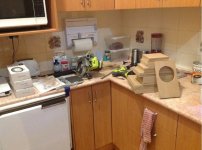Their website is still up: - E J Jordan
and the last edit on their FB page is like 3 days ago: Log into Facebook
We were discussing Ars Harmonia. 🙂
That would probably be a breach of Ars Harmonia's design copyright, and since he used Martin King's MathCad probably a breach of that licence as well. I do appreciate the offer though.
Someone can copyright a design, but that does not pre-clude you from making a copy.
Violation of the MJK licence only happens if you have not purchsed the one-time commercial licence and then start selling the design. For personal use is not an issue.
dave
I think the difference in price is probably largely due to where they are made.
All else being equal, would translam have more damping?
No the opposite, as the panels are used in a way that they loose their stiffness. For the same stiffness you need a way thicker wall than when using plywood the normal way. If you want more damping, the best method is bracing, for tops mass loading a thin wall lossy cabinet (with bitumen or others) can also work as it draws the resonance frequency down (the BBC method like used in the LS3/5A). But the simplest way is bracing a lot.
And wood moves, even plywood so cracks are often there with bigger translam build after some time and temp and humidity change. To avoid those cracks, many soak the wood in epoxy so they are stuck in their form and humidity can't reach them.
Thank you. Yes, I've read translam is not as stiff, although I'm not really clear as to why, I was wondering if it had more damping due to way the laminations are arranged and the shearing force between the wood and glue layers?
Everytime you have a transition from one ply to the other you have damping. The orientation of these in a translam is not that effective.
A thicker wall will typically provide greater damping, and stiffness goes up with the cube.
A sheet of MDF or plywood is specifically designed to be used as a sheet and that is the orientation of the maximal stiffness/strength. But in a translam you cut the stiffening surfaces up and use th ematerial in the least effective orientation.
So:
Advantage: an easy (brute force) method of generating shapes not easily achievable with sheet material
Disadvantages:
1/ usually huge wast.
2/ ignoring the waste use much more material
3/ needs thicker walls to approach the stiffness of the material used in th ecorrect orientation
4/ they tend to crack.
dave
A thicker wall will typically provide greater damping, and stiffness goes up with the cube.
A sheet of MDF or plywood is specifically designed to be used as a sheet and that is the orientation of the maximal stiffness/strength. But in a translam you cut the stiffening surfaces up and use th ematerial in the least effective orientation.
So:
Advantage: an easy (brute force) method of generating shapes not easily achievable with sheet material
Disadvantages:
1/ usually huge wast.
2/ ignoring the waste use much more material
3/ needs thicker walls to approach the stiffness of the material used in th ecorrect orientation
4/ they tend to crack.
dave
Someone can copyright a design, but that does not pre-clude you from making a copy.
Violation of the MJK licence only happens if you have not purchsed the one-time commercial licence and then start selling the design. For personal use is not an issue.
dave
Thanks Dave. Yeah, having been a tech for 40 years makes me over cautious I guess. I was exposed to a lot of trade secrets and restricted data.
In any case, it's a beautiful design but I prefer Ted's original concept with the invisible downfacing port.
The little J6T drivers arrived today. Apart from being 4 ohm nominal (and having a DCR of 3 ohms) I can't see much wrong with them. They'll do nicely for surround.
Everytime you have a transition from one ply to the other you have damping. The orientation of these in a translam is not that effective.
I don't see how that's the case? If you consider the way some braces are made in two parts with a bond between them that damps movement of the shear force wouldn't the bonds between the plys have a similar effect?
FWIW/YMMV: The way I visualize/'reason' it, each joint not bonded with a matching density, MOE specs is an impedance mismatch, so normally a massive constrained layer damping 'brick wall' scenario with a rule-of-thumb to presume the sum isn't even as much as the properties of an enclosed single lam sealed box construction, making the shape and/or its tie bars setting the structure's summed mass, MOE specs ~ the same as a suitably braced/anchored brick, etc., wall's.
IOW, there's no shearing forces when properly designed, constructed and damping is a 'robbing Peter to pay Paul' situation in that the more constrained layering increases mass, its construction is increasing stiffness with mass winning unless quite thick per the 'cubing' requirement, dropping the summed Fs, so usually fine for > ~200 Hz unless enough mass to lower Fs ~ an octave below the speaker's tuning and/or is properly damped via its base mounting scheme.
IOW, there's no shearing forces when properly designed, constructed and damping is a 'robbing Peter to pay Paul' situation in that the more constrained layering increases mass, its construction is increasing stiffness with mass winning unless quite thick per the 'cubing' requirement, dropping the summed Fs, so usually fine for > ~200 Hz unless enough mass to lower Fs ~ an octave below the speaker's tuning and/or is properly damped via its base mounting scheme.
- Home
- Loudspeakers
- Full Range
- My Eikonas have arrived!
